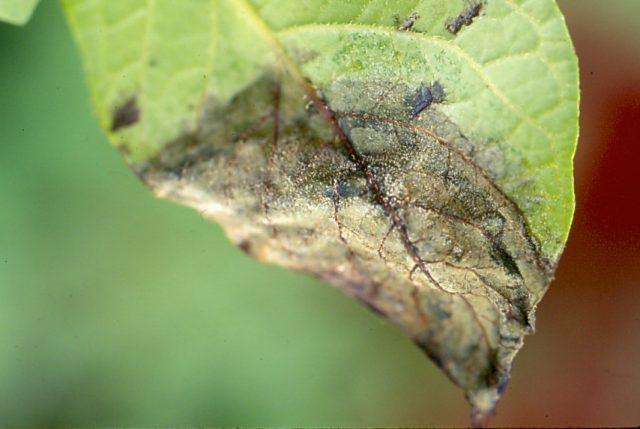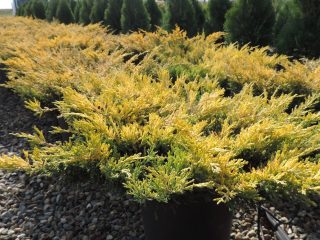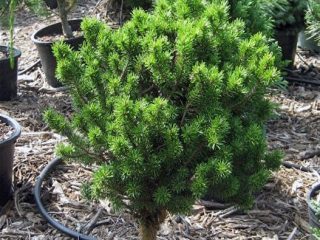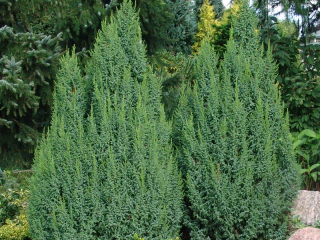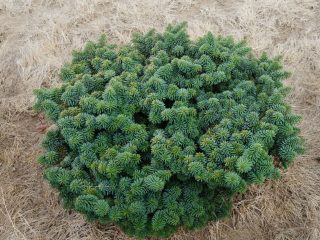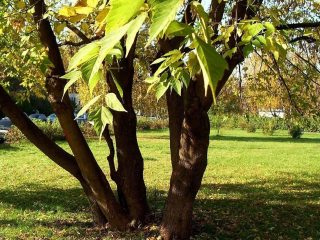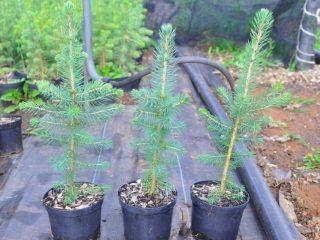Content
- 1 Description of paulownia with photo
- 2 Properties and applications of Adam's tree
- 3 Varieties and types of paulownia for Russia
- 4 How to plant paulownia
- 5 Caring for paulownia in open ground
- 6 Diseases and pests
- 7 Paulownia propagation methods
- 8 Paulownia in landscape design
- 9 Conclusion
- 10 Reviews from gardeners about paulownia
Photos and descriptions of paulownia deserve close attention. The plant does not require complex care and decorates the area, and also has numerous beneficial properties.
Description of paulownia with photo
Paulownia, or paulownia (Paulownia) is an ornamental plant of the Paulowniaceae family. The unusual name is explained by a simple mistake of German naturalists. They wanted to name the culture in honor of Anna Pavlovna, the daughter of Russian Emperor Paul I, but the word “Anna” was already occupied by another botanical genus.As a result, the plant was named after its patronymic - “Pavlovna”, mistakenly considering it to be its middle name.
What does a paulownia tree look like?
Paulownia is a tall, deciduous tree with a straight trunk and branched taproot. The underground system goes up to 6 m deep into the soil, so the crop is highly drought-resistant. The leaves are three-lobed with a solid edge, reach 30 cm in length, attached to the shoots on elongated green petioles in opposite order.
The size of paulownia depends on the variety. But on average, the girth of the trunk of an adult plant can be about 1.5 m. The bark of the tree is greenish when young, then acquires a brownish tint. The wide crown spreads an average of 6 m. The crop is characterized by very rapid growth and can add 1.5 m per year.

Paulownia reaches an average height of 9-15 m
How paulownia blooms
Paulownia usually begins to bloom at the end of April. The buds bloom on the branches of the tree earlier than the leaves, appear in large numbers and remain for one and a half months.
Flower petals can be white, pinkish or soft lilac, depending on the variety. The buds are bell-shaped and reach 30 cm in diameter. In the center of the flower, paulownia usually has a noticeable yellowish spot. The buds of the tree are collected in paniculate pyramidal inflorescences. When they bloom, they emit a strong, pleasant aroma and attract pollinators to the garden.
After flowering, paulownia produces ovoid fruits filled with small winged seeds. The bolls can remain on the tree branches for a long time and not fall off until next spring.
Winter hardiness of paulownia
Frost resistance of paulownia is quite high. Mature trees can withstand cold temperatures down to -25 °C even without shelter.If you provide paulownia with good insulation, it will be able to safely survive the winter in Siberia or the Urals.
Where does paulownia grow in Russia?
In Russia, paulownia is found most often in the Caucasus and Crimea. It takes root well in the southern regions - in the Krasnodar Territory, Rostov and Voronezh regions. It is possible to grow paulownia in Siberia, but caring for the tree can be associated with certain difficulties. In cold winters, the crop requires very careful shelter from wind and frost.
Properties and applications of Adam's tree
In summer cottages, paulownia is used to decorate the landscape, as well as to purify the air in areas with unfavorable ecology. The large leaf blades of the plant release large amounts of oxygen and trap dust.
Paulownia in central Russia is also planted to improve the structure of the soil. The long powerful root of the plant prevents weathering and erosion of the soil. The leaves are high in carbohydrates and proteins, making them a nutritious food for livestock.
Growing paulownia in the Urals and other regions is practiced to obtain high-quality light wood. The material has good density, does not readily absorb moisture and rarely suffers from fungus. The wood is not prone to bending or cracking and can be easily processed with tools. Paulownia is used in shipbuilding and for making musical instruments. The plant is used to produce paper raw materials and packaging materials.
Paulownia wood can serve as high-quality and inexpensive fuel. It is also used to make furniture and flooring. The material is used to create finishing in baths and saunas.
Varieties and types of paulownia for Russia
The paulownia tree in the Moscow region and other regions is represented by many varieties. There are several plants that are especially popular among Russian gardeners.
Tomentosa (Paulownia tomentosa)
Fast-growing paulownia is capable of adding up to 3 m per year, and in adulthood it reaches 20 m above the ground. The leaves of the tree are pale green, fibrous in structure, the inflorescences are white or pale lilac. Closer to autumn, fruits form on the shoots of paulownia, which do not fly off until winter. The tree is distinguished by lush, abundant and long-lasting flowering.
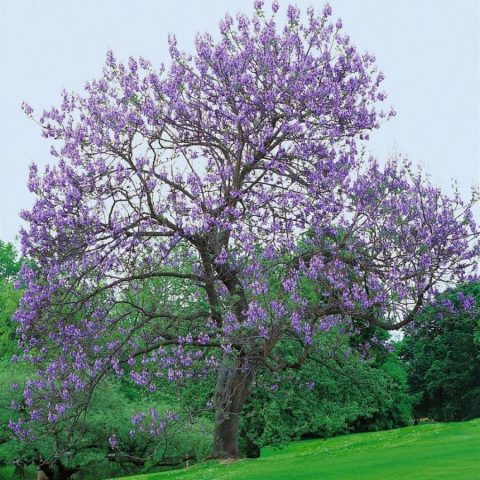
Felt paulownia is well suited for the Moscow region because it can withstand frosts down to -25 °C
Sapphire (Paulownia kawakamii)
Tall paulownia, up to 15 m above the ground, has very large leaf plates up to 45 cm in length. The crown of the tree is slightly elongated upward, ovoid. The frost resistance of the species is low, up to -17 °C, so it is recommended to plant the plant in southern regions with warm winters. The flowers of sapphire paulownia are deep blue with a yellow center, which explains the name.

Sapphire paulownia blooms in mid-spring for six weeks
Fortune (Paulownia fortunei)
Chinese paulownia is suitable for planting in warm coastal regions. It is distinguished by lush flowering, blooming with white or cream buds with a dark center. The leaves of the tree are light green with pubescence on the surface.
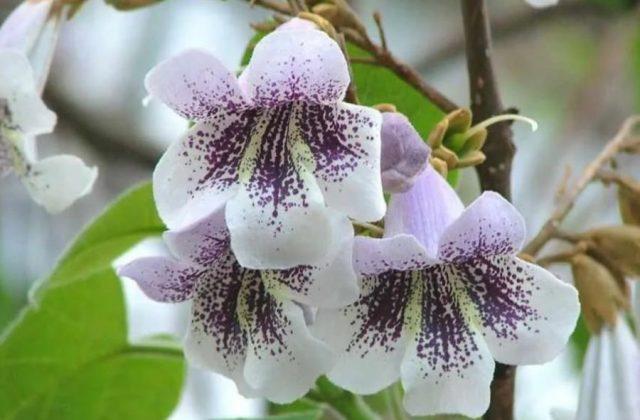
The height of Paulownia Fortune is about 12 m
Elongata (Paulownia elongata)
Recommended for growing in the Moscow region is Paulownia Elongata, which can withstand frosts down to -17 °C without shelter. The tree has a wide, dense crown and blooms with numerous light lavender buds.The flowers are collected in lush clusters and look very bright in landscape design.
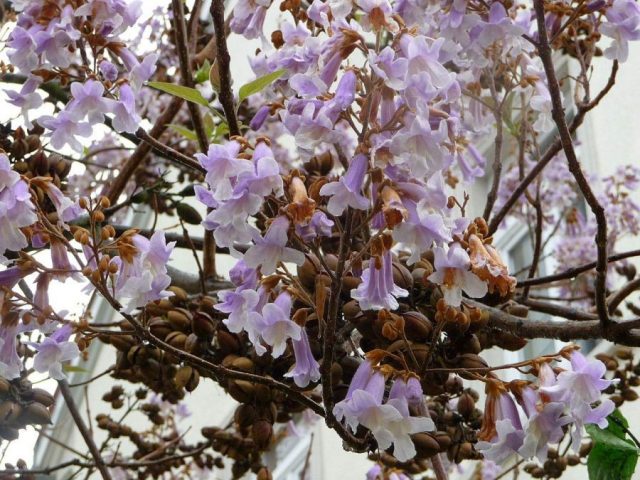
Paulownia Elongata can grow up to 4.5 m in the first year after planting
Fargeza (Paulownia fargesii)
A large variety of paulownia reaches 20 m above the ground. It is distinguished by a spreading and lush crown, the length of the plates is about 35 cm. In spring, the tree bears white or light yellow flowers, collected in lush panicles. Paulownia has good drought resistance.
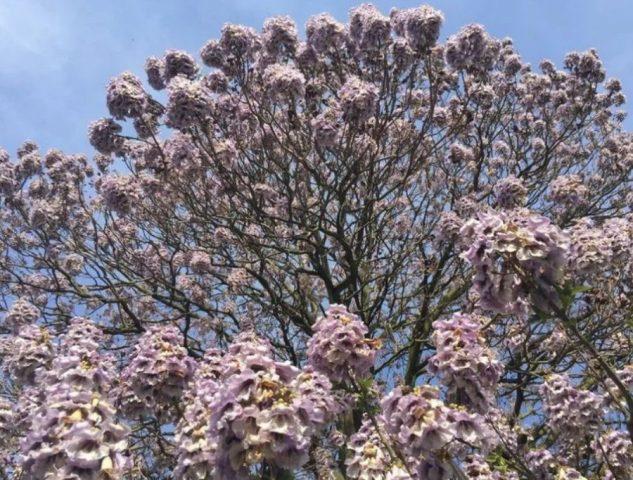
Paulownia Fargeza prefers to grow in warm and humid climates
How to plant paulownia
Paulownia should be planted in the ground in early spring or mid-autumn, while the plant is dormant. For the tree on the site, select an open and sunny or slightly shaded place with protection from strong winds. The crop needs loose, well-drained soil with a slightly acidic or slightly alkaline reaction. Soil with a high sand content is well suited for paulownia, but it is better not to place the tree in clay soil.
Direct planting of a crop on a site is carried out according to the following algorithm:
- The selected location is dug up and the soil composition is improved with sand and humus.
- Prepare a hole about 60 cm deep or more for the paulownia seedling.
- A drainage layer is placed on the bottom, and a substrate consisting of garden soil with the addition of peat is placed on top.
- Place the paulownia seedling in the center of the hole and spread the roots to the sides.
- The remaining voids are filled with soil.
Immediately after planting, paulownia is watered generously with lukewarm water. It is important to leave the root collar of the tree flush with the ground surface.When planting several plants, you need to provide at least 1 m of free space between them.
Caring for paulownia in open ground
Caring for paulownia on the site is not associated with great difficulties. When growing a tree, you need to pay attention to several points.
Watering paulownia
Paulownia has a developed root system and can extract moisture from deep layers of soil. Therefore, the tree needs abundant watering only during the first time after planting. It is also recommended to moisten the crop 2-3 times a week in hot and dry weather. Before the next watering, you need to wait until the soil is completely dry, and only after that add a large amount of water to the paulownia tree trunk.
When caring for young plants on the site, 10 liters of lukewarm, settled liquid are consumed per tree. An adult paulownia needs 15-20 liters of water.
How to feed paulownia
Fertilizers for paulownia are mainly nitrogen - such fertilizing contributes to the growth of green mass. It is recommended to add urea or ammonium nitrate to the water for irrigation once a week; you can also use chicken manure.
During the flowering period, you can feed the tree with vermicompost. The product contains all the necessary nutrients and promotes abundant budding of paulownia.
Paulownia pruning
It is possible to form a crown for paulownia, but the procedure is not mandatory. The branched tree retains beautiful outlines on its own; pruning is performed only if it is necessary to give the plant artistic contours.
For sanitary purposes, it is recommended to prune paulownia in the spring before active sap flow begins.During pruning, all dried and frozen branches of the plant are removed, as well as twisted shoots directed towards the center of the crown.
Diseases and pests
Paulownia has good immunity to fungi and parasites. But with insufficient care, the danger to the culture is:
- powdery mildew - the leaves of the tree become covered with a dry whitish coating, then turn yellow and fall off;
Powdery mildew of paulownia develops on acidified, damp soil.
- gray rot - fluffy mold forms on the plates, over time the greens begin to soften;
Gray mold of paulownia is caused by waterlogging of the soil at the roots.
- scale insect - light brown tubercles appear on the reverse side of paulownia leaves and a sticky coating appears;
If you do not fight the scale insect, the paulownia leaves will turn yellow and fall off.
If there are symptoms of fungal diseases, the tree is treated with Fundazol, Bordeaux mixture or copper sulfate. It is imperative to adjust the irrigation regime and prevent the soil from becoming waterlogged in the future.
Paulownia is sprayed against pests with Karbofos, Actellik and Aktara. If there are few insects on the leaves, you can use a regular soap solution or an infusion of onion peels.
Paulownia propagation methods
Paulownia can be propagated on the site by vegetative methods and using seeds. The seedling method is rarely used, since in this case the tree will develop rather slowly.
Propagation of paulownia by seeds
Growing paulownia from seeds at home is carried out in shallow plastic or ceramic containers filled with substrate with the addition of sand and peat.Sowing is done as follows:
- The soil in containers is shed generously with clean, soft water.
- Spread paulownia seeds on the surface of the soil.
- Cover the container with plastic wrap.
- Place in a warm, well-lit place for two weeks.
Every day, the container is opened briefly to ventilate. After sprouts form, the shelter is removed. Grown-up paulownia seedlings are planted in separate pots, and the next year the seedlings are transferred to open ground.
Propagation of paulownia by cuttings
Paulownia cuttings are a very simple and popular way to propagate a tree. In August or September, sections 5-8 cm long are cut off from the tops of the shoots, treated with a growth stimulator and placed in a nutrient substrate. The cuttings are moistened and covered with cut bottles on top.
When the shoots begin to grow, the mini-greenhouses will need to be removed. The strengthened cuttings are transferred to open soil in the next season, and throughout the winter they are cared for indoors.
Root suckers
Sometimes paulownia is propagated by root shoots - shoots that originate from the base of the trunk. In autumn or early spring, the shoots are carefully dug up and separated from the mother plant with a sharp tool.
Paulownia sections are treated with crushed coal or a solution of potassium permanganate to prevent rotting. Then the tree's shoots are immediately transplanted into prepared holes in the garden, sprinkled with soil and watered abundantly.
Paulownia in landscape design
The growth rate of paulownia allows the crop to be used for the urgent creation of green spaces that provide dense, extensive shade. The tree is placed next to gazebos and benches, as well as near residential buildings to protect windows from the bright sun.
Paulownia goes well with most perennials in a summer cottage. You can plant shade-tolerant and moisture-loving flowers in the tree trunk.
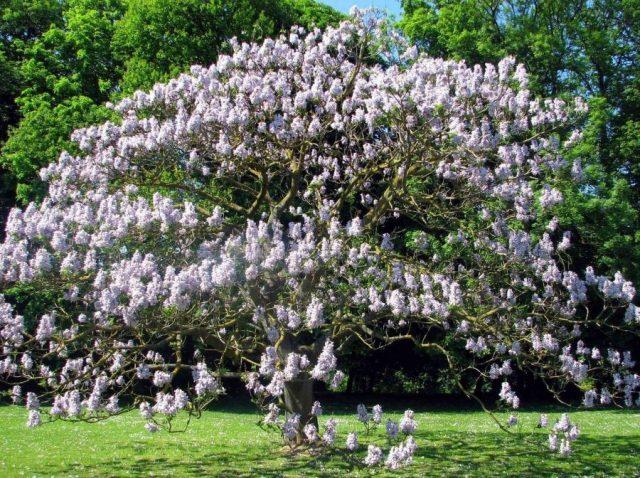
Paulownia can be placed near fruit trees to attract bees to the site
Conclusion
The photo and description of paulownia should be studied before planting the tree. The culture as a whole is unpretentious, but not all species are suitable for growing in regions with cold winters.
Reviews from gardeners about paulownia

